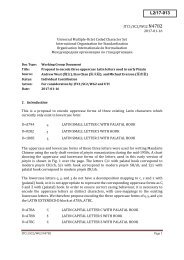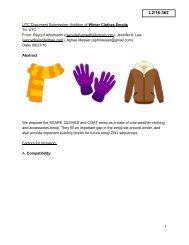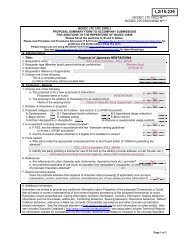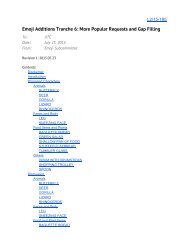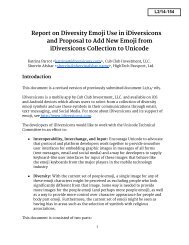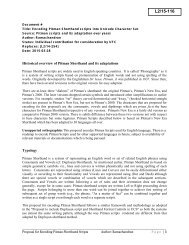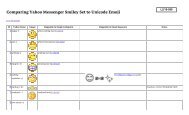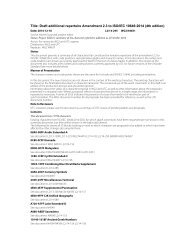Title Draft additional repertoire for ISO/IEC 10646:2016 (5th edition) CD.2
15339-n4705
15339-n4705
You also want an ePaper? Increase the reach of your titles
YUMPU automatically turns print PDFs into web optimized ePapers that Google loves.
2E30<br />
Supplemental Punctuation<br />
2E49<br />
2E30 ⸰ RING POINT<br />
• used in Avestan<br />
→ 2218 ∘ ring operator<br />
→ 25E6 ◦ white bullet<br />
2E31 ⸱ WORD SEPARATOR MIDDLE DOT<br />
• used in Avestan, Samaritan, ...<br />
→ 00B7 · middle dot<br />
Palaeotype transliteration symbol<br />
2E32 ⸲ TURNED COMMA<br />
• indicates nasalization<br />
→ 060C arabic comma<br />
Historic punctuation<br />
2E33 ⸳ RAISED DOT<br />
• glyph position intermediate between 002E .<br />
and 00B7 ·<br />
→ 002E . full stop<br />
→ 00B7 · middle dot<br />
2E34 ⸴ RAISED COMMA<br />
→ 002C , comma<br />
Palaeotype transliteration symbols<br />
2E35 ⸵ TURNED SEMICOLON<br />
• indicates sudden glottal closure<br />
→ 061B arabic semicolon<br />
2E36 ⸶ DAGGER WITH LEFT GUARD<br />
• indicates retracted pronunciation<br />
2E37 ⸷ DAGGER WITH RIGHT GUARD<br />
• indicates advanced pronunciation<br />
2E38 ⸸ TURNED DAGGER<br />
• indicates retroflex pronunciation<br />
→ 2020 † dagger<br />
2E39 ⸹ TOP HALF SECTION SIGN<br />
• indicates pronunciation on one side of the<br />
mouth only<br />
→ 00A7 § section sign<br />
Dashes<br />
2E3A ⸺ TWO-EM DASH<br />
= omission dash<br />
→ 2014 — em dash<br />
2E3B ⸻ THREE-EM DASH<br />
Alternate <strong>for</strong>ms of punctuation<br />
2E3C STENOGRAPHIC FULL STOP<br />
• used in shorthands and stenographies<br />
→ 002E . full stop<br />
→ 166E ᙮ canadian syllabics full stop<br />
2E3D VERTICAL SIX DOTS<br />
→ 205E ⁞ vertical four dots<br />
→ 2999 ⦙ dotted fence<br />
2E3E WIGGLY VERTICAL LINE<br />
→ 2307 ⌇ wavy line<br />
→ 299A ⦚ vertical zigzag line<br />
Historic punctuation<br />
2E3F CAPITULUM<br />
• ancestor of the pilcrow sign<br />
→ 00B6 pilcrow sign<br />
Double hyphen<br />
The double hyphen is used in transcription of old German<br />
manuscripts, and occasionally as a non-standard punctuation<br />
mark. It is not intended <strong>for</strong> the representation of normal<br />
hyphens, whose doubled <strong>for</strong>ms in Fraktur text are considered<br />
glyphic variants.<br />
2E40 DOUBLE HYPHEN<br />
→ 003D = equals sign<br />
→ 2010 ‐ hyphen<br />
→ 2E17 ⸗ double oblique hyphen<br />
→ 30A0 ゠ katakana-hiragana double hyphen<br />
→ A78A ꞊ modifier letter short equals sign<br />
Reversed punctuation<br />
2E41 REVERSED COMMA<br />
• also used in Sindhi<br />
→ 002C , comma<br />
→ 060C arabic comma<br />
2E42 DOUBLE LOW-REVERSED-9 QUOTATION MARK<br />
→ 201E „ double low-9 quotation mark<br />
Dash<br />
2E43 DASH WITH LEFT UPTURN<br />
Miscellaneous punctuation<br />
2E44 DOUBLE SUSPENSION MARK<br />
Typicon punctuation<br />
2E45 INVERTED LOW KAVYKA<br />
2E46 INVERTED LOW KAVYKA WITH KAVYKA ABOVE<br />
2E47 LOW KAVYKA<br />
→ A67E ꙾ cyrillic kavyka<br />
2E48 LOW KAVYKA WITH DOT<br />
2E49 DOUBLE STACKED COMMA<br />
68<br />
Printed: 14-Dec-2015




